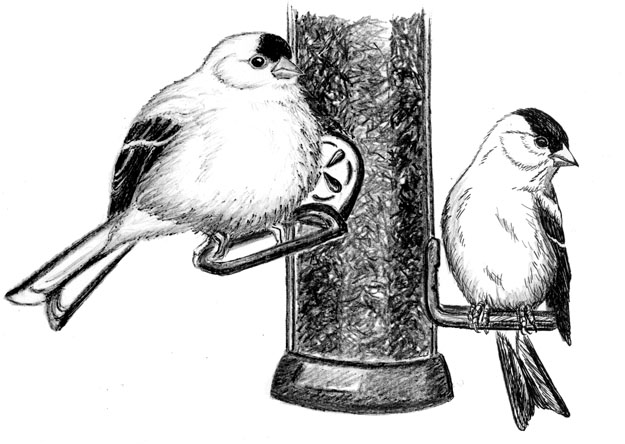
Dear Bird Folks,
Is this goldfinch pregnant (see attached photo) or did she swallow a tennis ball??? She must be pregnant because she looks like eggs are ready to pop out of her. Any thoughts?
– Debi, Eastham, MA
Let’s see, Debi,
My choices are either your goldfinch swallowed a tennis ball or it’s pregnant. Hmm. Let me think. After careful thought, I’m voting for the tennis ball theory. I realize that goldfinches rarely swallow balls of any kind, especially tennis balls, but that’s the only possibility. Why? Because the finch in your photo is a male. So unless he has had some work done, he can’t possibly be pregnant. Your goldfinch is probably just overweight because he’s middle aged, has stopped exercising and is spending too much time at Aunt Tweety’s All-You-Can-Eat Thistle Bar. It’s kind of a shame that he let himself go like that, but it happens to the best of us.
The truth is, unlike humans and their over-stuffed pets, you’ll never see any out-of-shape birds. I doubt the finch in your photo weighs more than any other goldfinch in your yard. What makes this bird look so large is that its feathers are all fluffed out. Birds fluff their feathers for several reasons. The most common reason is to stay warm in the winter. But it’s July now and no creature, bird or otherwise, is having trouble keeping warm this summer. The other reason for being fluffy is to look big and bad. Like an angry dog that makes its fur stand up, birds try to look larger when they are defending a territory or a food source. Only in this particular case those manly efforts seem to be wasted because instead of looking macho, you think Mr. Finch is pregnant. Probably not the look he was going for.
A more serious reason why a bird may fluff its feathers is because it’s not feeling well. As much as I hate to say it, birds don’t live forever. We want to believe that we have the same robins nesting in our spruce trees each spring or the same hummingbird returning to our feeders on April 27th every year. Some birds may return for a year or two or three, but most don’t. The returning birds are often the offspring or friends of the original birds. Predators, accidents and weather top the list of hazards that take a toll on birds. Disease is also a big problem. How does a bird get sick? Bird ailments can be caused by bacteria or viruses, and, of course, smoking. I know it’s hard to imagine a bird with a cigarette, but I hear that’s how puffins got their name.
Birds are susceptible to several common avian diseases, but I’m not going to list them here. The names of bird illnesses are long, hard to pronounce and look like the bottom line on an eye chart, with most ending in “–osis.” Sick birds behave much like we do when we aren’t feeling well. They will typically remain quiet, act lethargic and sit with their eyes closed. Their remedies are also like ours. They try to get plenty of rest, eat a proper diet and drink lots of liquids. However, they tend to avoid eating chicken soup completely. Chicken soup is definitely not good for a bird’s soul. When we get the chills we curl up with a comforter. Birds don’t use comforters (as with chicken soup, they are universally opposed to what comforters are made of). Instead, birds regulate their body heat by fluffing their feathers. It’s not unusual to see lots of birds fluffed out on a frigid winter day. But when a bird is puffy in the summer, it points to something else and that something else isn’t pregnancy.
What should we do if we see a sick bird at a feeder? There really isn’t much we can do. The bird will either be strong enough to shake off the illness on its own or it won’t. Even if the worst happens, don’t expect to see the bird’s body lying on the ground. More often than not a predator will intervene and finish off the compromised bird long before the illness does. Occasionally, you may see several unhealthy looking birds around your feeder. When that happens it’s time to take action. Seeing more than one sick bird is a sign that an illness is spreading. You should immediately do anything you can to discourage feeder birds from hanging out in your yard, including temporarily removing all of your feeders and birdbaths. But don’t worry. After about a week or so the ugliness should have run its course and it will be safe to put everything back out.
With your feeders out of action, it’s the perfect time to give them a long overdue cleaning. Take your feeders apart and soak them in a bucket of water. Some people recommend adding a mild (ten parts to one), bleach solution, but I use dish-washing liquid (because it keeps my hands soft and supple.) Once your feeders are totally clean, rinse them thoroughly and put them out in the sun to dry. While waiting for your feeders to dry, go outside and rake up under your feeding area. A yard filled with damp, moldy old shells, combined with bird droppings, can be a source of various avian illnesses…and it doesn’t do much for your property value, either.
Except for fluffed feathers, Debi, the male goldfinch in your photo doesn’t look too bad. His eyes are open and he seems alert. If he is indeed sick, perhaps he has a case of something mild and will recover. Maybe he’s just nauseous from watching the latest batch of political ads on TV. I know they’re starting to turn my stomach.